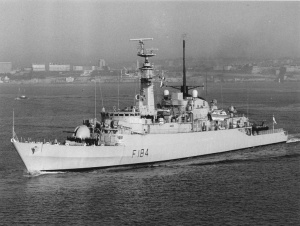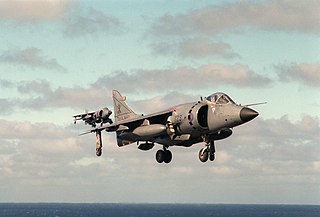
The Falklands War was a ten-week undeclared war between Argentina and the United Kingdom in 1982 over two British dependent territories in the South Atlantic: the Falkland Islands and its territorial dependency, South Georgia and the South Sandwich Islands.

HMS Hermes was a conventional British aircraft carrier and the last of the Centaur class.

HMS Invincible was the Royal Navy's lead ship of her class of three light aircraft carriers. She was launched on 3 May 1977 as the seventh ship to carry the name. She was originally designated as an anti-submarine warfare carrier, but was used as an aircraft carrier during the Falklands War, when she was deployed with HMS Hermes. She took over as flagship of the British fleet when Hermes was sold to India. Invincible was also deployed in the Yugoslav Wars and the Second Gulf War. In 2005, she was decommissioned, and was eventually sold for scrap in February 2011.
This is a list of the naval forces from the United Kingdom that took part in the Falklands War, often referred to as "the Task Force" in the context of the war. For a list of naval forces from Argentina, see Argentine naval forces in the Falklands War.

This article describes the composition and actions of the Argentine air forces in the Falklands War, which comprised units of the Air Force, Army, Navy and other services.

HMS Ardent was a Royal Navy Type 21 frigate. Built by Yarrow Shipbuilders Ltd, Glasgow, Scotland. She was completed with Exocet launchers in 'B' position. Ardent took part in the Falklands War, where she was sunk by Argentine aircraft in the Falkland Sound on 21 May 1982.

Atlantic Conveyor was a British merchant navy ship, registered in Liverpool, that was requisitioned during the Falklands War.
This article describes the composition and actions of the Argentine naval forces in the Falklands War. For a list of naval forces from the United Kingdom, see British naval forces in the Falklands War.

ARA Veinticinco de Mayo (V-2) was an aircraft carrier in the Argentine Navy from 1969 to 1997. The English translation of the name is Twenty-fifth of May, which is the date of Argentina's May Revolution in 1810.

ARA San Luis (S-32) was a Type 209 diesel-powered submarine of the Argentine Navy. Built in Germany, San Luis has a displacement of 1,285 tonnes and was commissioned in 1974. The submarine operated against the Royal Navy during the Falklands War without any noticeable success, but survived a number of anti-submarine sweeps carried out by British frigates. San Luis was struck in 1997 after an incomplete overhaul.

ARA Bahía Buen Suceso (B-6) was a Bahía Aguirre-class 5,000-ton fleet transport that served in the Argentine Navy from 1950 to 1982. She took part in the Falklands War as a logistics ship tasked with resupplying the Argentine garrisons scattered around the Falkland Islands. Captured by British forces on 15 June after running aground at Fox Bay, she sank in deep waters while being used as target practice by the Royal Navy on 21 October 1982.
These are some of the key weapons of the Falklands War used by both sides.

The Raid on Pebble Island was a raid by British Special Forces on Pebble Island's airfield during the Falklands War, and took place on the night of 14–15 May 1982. Pebble Island is one of the smaller Falkland Islands, lying north of West Falkland. The site was being used as a forward operating base for T-34 Mentor and Pucara aircraft by the Argentine Air Force; British Special Air Service (SAS) operatives were tasked with destroying the aircraft on the ground, in an operation that echoed back to some of the unit's first missions during the North African Campaign of World War II. SAS elements, then embarked on HMS Hermes, were tasked with eliminating the airfield, with naval support from the Type 22 frigate HMS Broadsword as Hermes defensive escort and the County-class destroyer HMS Glamorgan to provide naval gunfire support with its Mark 6 4.5 inch guns.

This is a list of the units, aircraft and casualties of the British air services in the Falklands War. The numbers in bold are the number of aircraft used in the war, the numbers in brackets are the number of lost aircraft. For a list of air forces from Argentina, see Argentine air forces in the Falklands War.
801 Naval Air Squadron (NAS) was a Fleet Air Arm squadron of the Royal Navy formed in 1933 which fought in World War II, the Korean War and the Falklands War.

The aftermath of the 1982 Falklands War between the United Kingdom and Argentina affected world geopolitics, the local political culture in Argentina and the UK, military thought, medical treatment, and the lives of those who were directly involved in the war.

The Bluff Cove air attacks occurred 8 June 1982, during the Falklands War. British troop transport ships were bombed by the Argentine Air Force (FAA) while unloading at Bluff Cove, with significant damage and casualties.

The Battle of San Carlos was a battle between aircraft and ships that lasted from 21 to 25 May 1982 during the British landings on the shores of San Carlos Water in the 1982 Falklands War. Low-flying land-based Argentine jet aircraft made repeated attacks on ships of the British Task Force.

ARA Alférez Sobral (A-9) is an 800-ton ocean-going tug that was in service with the Argentine Navy from 1972 until 2019, where she was classified as an aviso. She had previously served in the US Navy as the fleet tug USS Salish (ATA-187). In Argentine service an aviso is a small naval vessel used for a number of auxiliary tasks, including tugging, laying buoys, and replenishing other ships, lighthouses and naval bases.
David Henry Spencer Morgan is a former British Navy and RAF pilot who flew on attachment to the Fleet Air Arm of the Royal Navy during the Falklands War in 1982 where he became the most successful British fighter pilot of the conflict and was also involved in the last dogfight by British fighter pilots in which enemy aircraft were destroyed.














